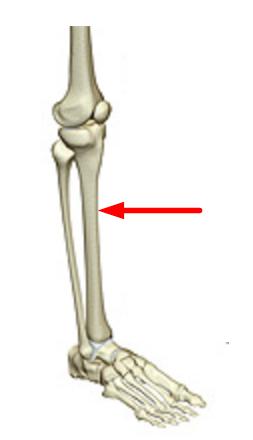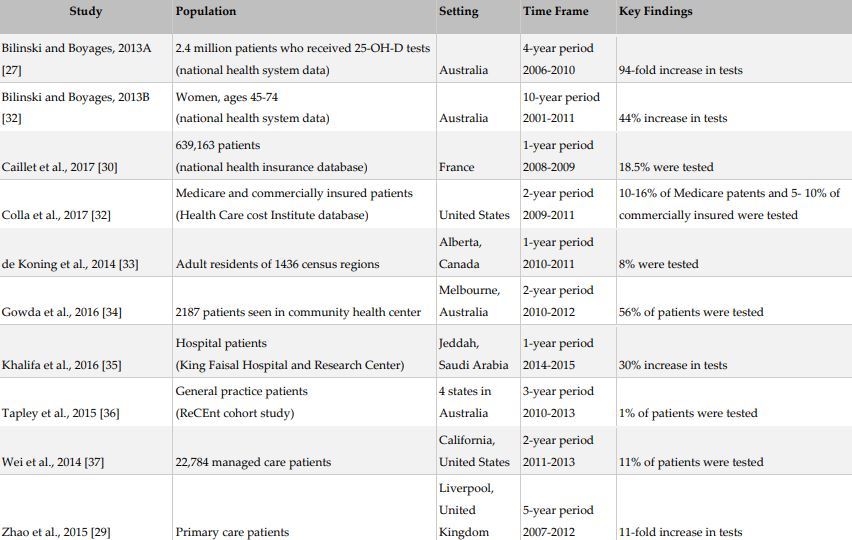Who needs a vitamin D test -Those with symptoms or those in high risk groups
Clinical Management of Low Vitamin D: A Scoping Review of Physician Practices
J. Clinical Management of Low Vitamin D: (doi: 10.20944/preprints201803.0131.v1)..)
Michelle Rockwell * , Vivica Kraak , Matthew Hulver , John Epling

 From the study
| | | | |
| --- | --- | --- | --- |
| | Population-wide 25-OH-D screening recommended? | 25-OH-D testing for individuals at high risk of deficiency recommended? | Definition of "high risk" |
| Public Health England
From the study
| | | | |
| --- | --- | --- | --- |
| | Population-wide 25-OH-D screening recommended? | 25-OH-D testing for individuals at high risk of deficiency recommended? | Definition of "high risk" |
| Public Health EnglandNational Osteoporosis Society, 2017 | No | Yes | Symptoms indicative of rickets, osteomalacia or symptomatic hypocalcaemia | | U.S. Preventive Services Task Force, 2015 | Current evidence is insufficient to assess The balance of benefits and harms of screening in asymptomatic adults (I statement) | n/a | n/a | | American Academy of Family Physicians, 2014 | Current evidence is insufficient to assess the balance of benefits and harms of screening for vitamin D deficiency (I) | No | n/a | | Canadian Medical Association, 2012 | No | Yes | Significant renal or liver disease
Osteomalacia, osteopenia or osteoporosis
Malabsorptionsyndromes
Hypo or hypercalcemia/ hyperphosphatemia
Hypo or Hyperparathyroidism
Patients on medications that affect vitamin D metabolism or absorption
Unexplained increased levels of serum alkaline phosphatase
Patients taking high doses of vitamin D (> 2000 IU daily) for extended periods of time (> 6 months), and who are exhibiting
symptoms suggestive of vitamin D toxicosis (hypervitaminosis D) | | U.S. Endocrine Society, 2011 | No | Yes | Rickets, osteomalacia, osteoporosis
Chronic kidney disease
Hepatic failure
Malabsorption syndromes Certain medications
African-American and Hispanic children and adults
Pregnant and lactating women
Older adults with history of falls or non-traumatic fracturesObese children and adults
Granuloma-forming disorders
Some lymphomas | | Kidney Disease Outcomes
Quality Initiative (KDOQI), 2009 | No | Yes | • Stage 3 or 4 kidney disease |
Studies of increased Vitamin D Testing

The role of vitamin D in the prevention and treatment of non-skeletal health issues has received significant media and research attention in recent years. Costs associated with clinical management of low vitamin D (LVD) have increased exponentially. However, no clear evidence supports vitamin D screening to improve health outcomes. Authoritative bodies and professional societies recommend against population-wide vitamin D screening in community-dwelling adults who are asymptomatic or at low risk of LVD. In order to assess patterns of physician management of LVD in this conflicting environment, we conducted a scoping review of three electronic databases and gray literature.
Thirty-eight records met inclusion criteria and were summarized in an evidence table.
Results from seven countries showed a consistent increase in vitamin D lab tests and related costs.
Many vitamin D testing patterns reflected screening rather than targeted testing for individuals at high risk of vitamin D deficiency or insufficiency. Interventions aimed at managing inappropriate clinical practices related to LVD were effective in the short term.
Variability and controversy were pervasive in many aspects of vitamin D management, shining light on physician practices in the face of uncertainty.
Future research is needed is needed to inform better clinical guidelines and to assess implementation practices that encourage evidence-based management of LVD in adult populations.
